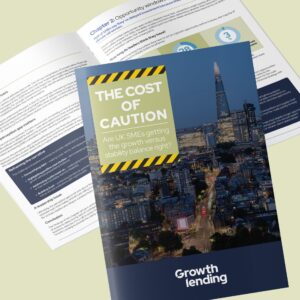Working capital: Why is it important for business growth?

Working capital is a fundamental part of any business’ success – after all, cash is king. But what about the specific impact that working capital can have on a business’ growth? And how can businesses use working capital most effectively to accelerate this growth?
We break it down…
What is working capital?
Working capital, also known as net working capital, is a financial metric that measures a company’s liquidity and short-term financial health. In simple terms, it is the cash that is needed to keep a business running day-to-day.
Working capital represents the difference between a company’s current assets and its current liabilities:
- Current assets include cash, accounts receivable and inventory
- While current liabilities include accounts payable and short-term debt
Working capital is often an indicator of a business’s financial health, as it reflects the company’s ability to fund its day-to-day operations and meet its short-term financial obligations. Positive working capital indicates that a company has enough readily-available cash to cover its current liabilities, while negative working capital indicates a cash deficiency.
Many fast-growing businesses find that their working capital is quickly eaten up as they win increasingly large clients and contracts. In these instances, the business can be highly successful, with a positive growth profile and still struggle with cash flow – which is why it is important that lenders take a holistic view of a business’ performance.
Why is working capital important in a business?
Working capital is important for several reasons:
- A bill of good health
Firstly, as above, it is often considered a sound measure of a company’s financial health, because positive working capital indicates that a company has enough current assets to cover its short-term financial obligations such as paying employees, paying suppliers and covering overheads. This ensures that the business can continue its operations smoothly and avoid any disruptions. - Working capital efficiency = business efficiency
Managing working capital effectively helps reduce the operating cycle of a business – this is the time it takes for a company to convert its investment in inventory and/or other assets into cash generated through sales. A reduction in the time it takes to move through this cycle improves the overall efficiency of a business and makes it more likely that there will be cash spare to invest in additional growth opportunities. - Capital is king when things go wrong
A strong working capital position can also protect a business from the unexpected. When the going gets tough, cash is king and the ability to cover short-term expenses, even when facing unforeseen obstacles can help a business to avoid more significant financial difficulty and ultimately, falling over.
How can working capital help your business grow?
Given the above, working capital can play a crucial role in helping a business to grow. Here’s a list of some of the key ways that working capital impacts a business’s growth:
- Funding growth
The most obvious – a positive working capital position means your business has the financial flexibility to invest in new products, expand into new markets and/or acquire other businesses. It means you have the necessary cash flow to support whatever growth initiatives are most appropriate and empowers you to take advantage of opportunities that will give you a competitive edge, as they arise. - Sustaining growth
Investing in growth is all well and good, but for your business to succeed long term, this investment must be financially sustainable. Effective working capital management ensures your business’ cash flow remains healthy even when investing in new opportunities – and means that you can keep doing it! - Strength in your numbers
A strong working capital position usually means a strong financial position. And aside from the benefits of liquidity already discussed (meeting short-term financial obligations, paying suppliers, maintaining good relationships), healthy finances become even more important when you are ready to take growth to the next level and seek out external investment. A demonstrable track record of your working capital management can go a long way in boosting your business’s credibility when meeting with potential investors. - Weathering the storm
Having sufficient accessible cash provides a buffer for unexpected expenses or a decline in sales – this is always important, but when you are aiming to grow, it gives the business the stability and resilience to navigate tough times and continue on your growth trajectory.
The benefits of using working capital to finance growth
The reason that using working capital to finance growth has a positive impact on businesses is that it’s almost impossible to do successfully without good working capital management – and good working capital management benefits a business in all kinds of ways:
- Improved operational efficiency – Effective working capital management usually has the knock-on effect of optimising other operations and processes, improving the overall efficiency of a business
- Close control on finances – A close eye on working capital requires a close eye on general finances, enabling leaders to make better-informed decisions and forecast performance more accurately
- Flexibility to adapt to market conditions – Using working capital to invest in growth means a business can respond quickly to changes in the market, without having to fundraise for separate and specific initiatives
But this isn’t to say that all working capital must be available organically. Many fast-growing businesses struggle with their working capital cycle because so much cash is invested upfront, in product or service development. In these instances, businesses can secure external finance to enhance their working capital position and use this cash to invest in growth.
How to enhance working capital
There are two main ways that a business can improve its working capital position.
The first, is by tidying up the obstacles that are created within the business; optimising the cash flow cycle, managing inventory, negotiating favourable terms, etc. You can read more about these strategies here.
But at some point, even the most streamlined business is going to struggle if it wants to grow substantially, particularly if the business is in a high-growth sector, which often entails significant up front costs. In these instances, a business might benefit from raising external finance to enhance working capital.
Borrow to increase your working capital
Borrowing can be an effective way to increase your working capital and provide the necessary funds for business growth – and depending on your business model, can be a more efficient and/or cost effective strategy than waiting to fund growth organically or raising capital via equity.
Here are some options to consider:
- Loan from a bank – A better option for more established businesses, with a strong track record. High growth businesses often do not meet banks’ lending criteria.
- Loan from a specialist lender – A better option for high growth businesses and those in specialist sectors; these lenders have a broader credit appetite and a better understanding of your business model
- Factoring or invoice discounting – Leverage your accounts receivable, either invoice-by-invoice, or your whole ledger to raise a larger sum
- Line of credit: Secure a line of credit from a bank or financial institution, which provides access to funds as needed and you generally only pay interest on the sum you draw down
Is it a good idea to use working capital to finance your business growth?
Realistically, the answer is both yes and no.
Working capital can impact a business’ growth in all the ways already discussed and enhancing your working capital position can go a long way in freeing up cash so that you can re-invest in new and exciting growth initiatives.
However, using working capital alone to fund growth, is probably not the wisest long term strategy.
As your business gets bigger, it is likely that you’ll need larger and larger sums to invest in substantial growth initiatives. The larger the sum, the more of an impact it could have on your working capital position and the more exposed you are to any fluctuation in cash flow. This could be a risky move in today’s challenging trading environment.
The strongest success stories we have seen are where businesses secure funds that enhance their working capital and use the cash injection for either very specific purposes, or to bridge a gap as they prepare for a larger fundraise. For example:
- Consumer goods businesses that face very high production costs, but do not receive payment from wholesale customers for several weeks, or even months later – they use invoice finance to enhance working capital and keep cash flow healthy, while they continue to grow and prepare for a larger fundraise.
- Businesses that have a very specific growth activity in mind – the acquisition of a complimentary firm for example – might leverage their accounts receivable to give working capital a temporary boost so that they can afford to move quickly
- More established businesses that are pursuing multiple growth strategies might raise a substantial sum and either use some of this sum to enhance working capital alongside growth investment OR secure working capital funds alongside the growth funds
Making working capital work for you
When thinking about enhancing your working capital position via external investment, the key to success is finding a lending partner that can work flexibly and creatively, so that you are getting the funding solution that is truly the right fit for your business and where your business is at in its lifecycle.
For more information on working capital and the role it can play in your growth trajectory, reach out to a member of our expert team, who will be more than happy to advise.



